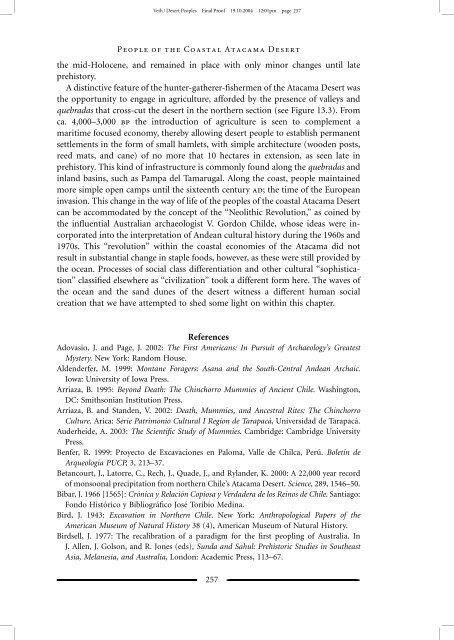You also want an ePaper? Increase the reach of your titles
YUMPU automatically turns print PDFs into web optimized ePapers that Google loves.
Veth / <strong>Desert</strong> <strong>People</strong>s Final Pro<strong>of</strong> 19.10.2004 12:01pm page 257<strong>People</strong> <strong>of</strong> <strong>the</strong> <strong>Coastal</strong> <strong>Atacama</strong> <strong>Desert</strong><strong>the</strong> mid-Holocene, and remained in place with only minor changes until lateprehistory.A distinctive feature <strong>of</strong> <strong>the</strong> hunter-ga<strong>the</strong>rer-fishermen <strong>of</strong> <strong>the</strong> <strong>Atacama</strong> <strong>Desert</strong> was<strong>the</strong> opportunity to engage in agriculture, afforded by <strong>the</strong> presence <strong>of</strong> valleys andquebradas that cross-cut <strong>the</strong> desert in <strong>the</strong> nor<strong>the</strong>rn section (see Figure 13.3). Fromca. 4,000–3,000 bp <strong>the</strong> introduction <strong>of</strong> agriculture is seen to complement amaritime focused economy, <strong>the</strong>reby allowing desert people to establish permanentsettlements in <strong>the</strong> form <strong>of</strong> small hamlets, with simple architecture (wooden posts,reed mats, and cane) <strong>of</strong> no more that 10 hectares in extension, as seen late inprehistory. This kind <strong>of</strong> infrastructure is commonly found along <strong>the</strong> quebradas andinland basins, such as Pampa del Tamarugal. Along <strong>the</strong> coast, people maintainedmore simple open camps until <strong>the</strong> sixteenth century ad; <strong>the</strong> time <strong>of</strong> <strong>the</strong> Europeaninvasion. This change in <strong>the</strong> way <strong>of</strong> life <strong>of</strong> <strong>the</strong> peoples <strong>of</strong> <strong>the</strong> coastal <strong>Atacama</strong> <strong>Desert</strong>can be accommodated by <strong>the</strong> concept <strong>of</strong> <strong>the</strong> ‘‘Neolithic Revolution,’’ as coined by<strong>the</strong> influential Australian archaeologist V. Gordon Childe, whose ideas were incorporatedinto <strong>the</strong> interpretation <strong>of</strong> Andean cultural history during <strong>the</strong> 1960s and1970s. This ‘‘revolution’’ within <strong>the</strong> coastal economies <strong>of</strong> <strong>the</strong> <strong>Atacama</strong> did notresult in substantial change in staple foods, however, as <strong>the</strong>se were still provided by<strong>the</strong> ocean. Processes <strong>of</strong> social class differentiation and o<strong>the</strong>r cultural ‘‘sophistication’’classified elsewhere as ‘‘civilization’’ took a different form here. The waves <strong>of</strong><strong>the</strong> ocean and <strong>the</strong> sand dunes <strong>of</strong> <strong>the</strong> desert witness a different human socialcreation that we have attempted to shed some light on within this chapter.ReferencesAdovasio, J. and Page, J. 2002: The First Americans: In Pursuit <strong>of</strong> Archaeology’s GreatestMystery. New York: Random House.Aldenderfer, M. 1999: Montane Foragers: Asana and <strong>the</strong> South-Central Andean Archaic.Iowa: University <strong>of</strong> Iowa Press.Arriaza, B. 1995: Beyond Death: The Chinchorro Mummies <strong>of</strong> Ancient Chile. Washington,DC: Smithsonian Institution Press.Arriaza, B. and Standen, V. 2002: Death, Mummies, and Ancestral Rites: The ChinchorroCulture. Arica: Serie Patrimonio Cultural I Region de Tarapacá, Universidad de Tarapacá.Auderheide, A. 2003: The Scientific Study <strong>of</strong> Mummies. Cambridge: Cambridge UniversityPress.Benfer, R. 1999: Proyecto de Excavaciones en Paloma, Valle de Chilca, Perú. Boletín deArqueología PUCP, 3, 213–37.Betancourt, J., Latorre, C., Rech, J., Quade, J., and Rylander, K. 2000: A 22,000 year record<strong>of</strong> monsoonal precipitation from nor<strong>the</strong>rn Chile’s <strong>Atacama</strong> <strong>Desert</strong>. Science, 289, 1546–50.Bibar, J. 1966 [1565]: Crónica y Relación Copiosa y Verdadera de los Reinos de Chile. Santiago:Fondo Histórico y Bibliográfico José Toribio Medina.Bird, J. 1943: Excavation in Nor<strong>the</strong>rn Chile. New York: Anthropological Papers <strong>of</strong> <strong>the</strong>American Museum <strong>of</strong> Natural History 38 (4), American Museum <strong>of</strong> Natural History.Birdsell, J. 1977: The recalibration <strong>of</strong> a paradigm for <strong>the</strong> first peopling <strong>of</strong> Australia. InJ. Allen, J. Golson, and R. Jones (eds), Sunda and Sahul: Prehistoric Studies in Sou<strong>the</strong>astAsia, Melanesia, and Australia, London: Academic Press, 113–67._ 257_
















